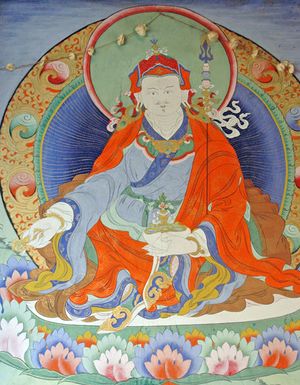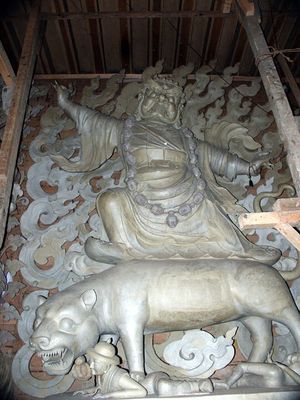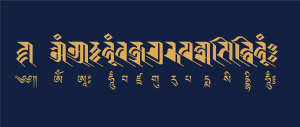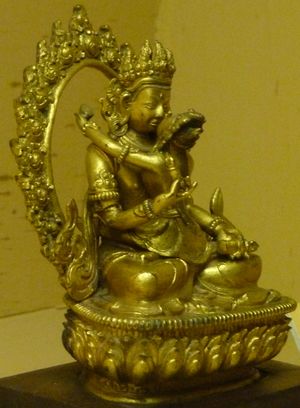پادماسمبهاڤا
Padmasambhava | |
|---|---|
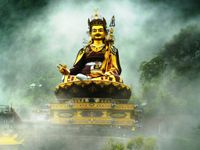 Statue of Padmasambhava 123 ft. (37.5 m) high in mist overlooking Rewalsar Lake, Himachal Pradesh, India |
|
جزء من سلسلة عن البوذية التبتية | |
|---|---|
| التاريخ | |
| خط زمني • المواضيع المتعلقة | |
| المدارس | |
| Nyingma • Kagyu • ساكيا • Gelug • بون | |
| المفاهيم الرئيسية | |
| علامات الوجود الثلاثة • سكانذا • Cosmology • سمسارا • Rebirth • بوذيساتڤا • دارما • Dependent Origination • كارما | |
| الشخصيات الرئيسية | |
| گاوتاما بوذا • پادماسمبهاڤا • Je Tsongkhapa • دالاي لاما • پانچن لاما • لاما • كارماپا لاما • رينپوچى • گشى • ترتون • تولكو | |
| Buddhahood • Avalokiteśvara • مراحل الاستنارة الأربعة • يوگا تانترية • Paramitas • التعبد • Laity | |
| Changzhug • Drepung • Dzogchen • Ganden • جوخانگ • كومبوم • لابرانگ • Mindroling • نامگيال • نارثانگ • Nechung • Pabonka • Palcho • Ralung • Ramoche • ساكيا • سانگا • سـِرا • شالو • Tashilhunpo • Tsurphu • يرپا | |
| Chotrul Duchen • Dajyur • لوسار • مونلام • شو دون | |
| النصوص | |
| Kangyur • تنگيور • النصوص المقدسة التبتية • ماهايانا سوترا | |
| مندلا رملية • Thangka • أشتامنگلا • Tree of physiology | |
پادماسمبهاڤا Padmasambhava [note 1] (lit. "Lotus-Born"), also known as Guru Rinpoche, was an 8th-century Indian Buddhist master. Although there was a historical Padmasambhava, nothing is known of him apart from helping the construction of the first Buddhist monastery in Tibet at Samye, at the behest of Trisong Detsen,[1] and shortly thereafter leaving Tibet due to court intrigues.[2]
A number of legends have grown around Padmasambhava's life and deeds, and he is widely venerated as a 'second Buddha' across Tibet, Nepal, Bhutan, and the Himalayan states of India.[3][4]
In Tibetan Buddhism, he is a character of a genre of literature called terma,[2] an emanation of Amitābha that is said to appear to tertöns in visionary encounters and a focus of guru yoga practice, particularly in the Rimé schools. The Nyingma school considers Padmasambhava to be a founder of their tradition.[5]
. . . . . . . . . . . . . . . . . . . . . . . . . . . . . . . . . . . . . . . . . . . . . . . . . . . . . . . . . . . . . . . . . . . . . . . . . . . . . . . . . . . . . . . . . . . . . . . . . . . . . . . . . . . . . . . . . . . . . . . . . . . . . . . . . . . . . . . . . . . . . . . . . . . . . . . . . . . . . . . . . . . . . . . .
Mythos
المصادر
Nyangrel Nyima Özer (1136-1204) was the principal architect of the Padmasambhava mythos according to Janet Gyatso.[6] Guru Chöwang (1212–1270) was the next major contributor to the mythos.[6]
In the eleventh and twelfth centuries there were several competing terma traditions surrounding Padmasambhava, Vimalamitra, Songtsän Gampo, and Vairotsana.[7] At the end of the 12th century, there was the "victory of the Padmasambhava cult,"[8] in which a much greater role is assigned to the role of Padmasambhava in the introduction of Buddhism to Tibet.[9]
التصوير والتجليات والصفات
التصوير
التجليات الثمانية
تعاليمه وممارساته
The Vajra Guru mantra
Consorts and twenty five main disciples
Many of those who gathered around Padmasambhava became advanced tantric practitioners as well as helping to found and propagate the Nyingma tradition. The most prominent of these include Padmasambhava's five main female consorts, also known as dakinis and his twenty five main disciples.
The five main consorts or five wisdom dakinis
ترجمات

King Trisong Detsen ordered the translation of all Buddhist Dharma Texts into Tibetan. Padmasambhava, Shantarakṣita, 108 translators, and 25 of Padmasambhava's nearest disciples worked for many years in a gigantic translation-project. The translations from this period formed the base for the large scriptural transmission of Dharma teachings into Tibet. Padmasambhava supervised mainly the translation of Tantra; Shantarakshita concentrated on the Sutra-teachings.
معرض صور
المدخل إلى Dawa Puk، كهف Guru Rinpoche Yerpa, 1993.
Statue of Guru Rinpoche in his meditation cave at Yerpa، التبت.
انظر أيضاً
ملاحظات
. . . . . . . . . . . . . . . . . . . . . . . . . . . . . . . . . . . . . . . . . . . . . . . . . . . . . . . . . . . . . . . . . . . . . . . . . . . . . . . . . . . . . . . . . . . . . . . . . . . . . . . . . . . . . . . . . . . . . . . . . . . . . . . . . . . . . . . . . . . . . . . . . . . . . . . . . . . . . . . . . . . . . . . .
الهامش
- ^ Kværne, Per (2013). Tuttle, Gray; Schaeffer, Kurtis R. (eds.). The Tibetan history reader. New York: Columbia University Press. p. 168. ISBN 9780231144698.
- ^ أ ب Schaik, Sam van. Tibet: A History. Yale University Press 2011, page 34-5, 96-8.
- ^ "Padmasambhava". Encyclopædia Britannica. Retrieved 5 October 2015.
- ^ Buswell, Robert E.; Lopez, Jr., Donald S. (2013). The Princeton dictionary of Buddhism. Princeton: Princeton University Press. p. 608. ISBN 9781400848058. Retrieved 5 October 2015.
- ^ Harvey, Peter (2008). An Introduction to Buddhism Teachings, History and Practices (2 ed.). Cambridge: Cambridge University Press. p. 204. ISBN 9780521676748. Retrieved 6 October 2015.
- ^ أ ب Gyatso, Janet (August 2006). "A Partial Genealogy of the Lifestory of Ye shes mtsho rgyal". The Journal of the International Association of Tibetan Studies (2).
- ^ Davidson, Ronald M. Tibetan Renaissance. pg 229. Columbia University Press, 2005.
- ^ Davidson, Ronald M. Tibetan Renaissance. pg 278. Columbia University Press, 2005.
- ^ Schaik, Sam van. Tibet: A History. Yale University Press 2011, page 96.
المصادر
- Berzin, Alexander (November 10–11, 2000). "History of Dzogchen". Study Buddhism. Retrieved 20 June 2016.
{{cite web}}: Invalid|ref=harv(help) - Bischoff, F.A. (1978). Ligeti, Louis (ed.). "Padmasambhava est-il un personnage historique?". Csoma de Körös Memorial symposium. Budapest: Akadémiai Kiadó: 27–33. ISBN 963-05-1568-7.
- Boord, Martin (1993), Cult of the Deity Vajrakila, Institute of Buddhist Studies, ISBN 0-9515424-3-5
- Dudjom Rinpoche The Nyingma School of Tibetan Buddhism: Its Fundamentals and History. Translated by Gyurme Dorje and Matthew Kapstein. Boston: Wisdom Publications. 1991, 2002. ISBN 0-86171-199-8.
- Guenther, Herbert V. (1996), The Teachings of Padmasambhava, Leiden: E.J. Brill, ISBN 90-04-10542-5
- Harvey, Peter (1995), An introduction to Buddhism. Teachings, history and practices, Cambridge University Press
- Heine, Steven (2002), Opening a Mountain. Koans of the Zen Masters, Oxford: Oxford University Press
- Jackson, D. (1979) 'The Life and Liberation of Padmasambhava (Padma bKaí thang)' in: The Journal of Asian Studies 39: 123-25.
- Jestis, Phyllis G. (2004) Holy People of the World Santa Barbara: ABC-CLIO. ISBN 1576073556.
- Kinnard, Jacob N. (2010) The Emergence of Buddhism Minneapolis: Fortress Press. ISBN 0800697480.
- Laird, Thomas. (2006). The Story of Tibet: Conversations with the Dalai Lama. Grove Press, New York. ISBN 978-0-8021-1827-1.
- Morgan, D. (2010) Essential Buddhism: A Comprehensive Guide to Belief and Practice Santa Barbara: ABC-CLIO. ISBN 0313384525.
- Norbu, Thubten Jigme; Turnbull, Colin (1987), Tibet: Its History, Religion and People, Penguin Books, ISBN 0140213821
- Snelling, John (1987), The Buddhist handbook. A Complete Guide to Buddhist Teaching and Practice, London: Century Paperbacks
- Sun, Shuyun (2008), A Year in Tibet: A Voyage of Discovery, London: HarperCollins, ISBN 978-0-00-728879-3
- Taranatha The Life of Padmasambhava. Shang Shung Publications, 2005. Translated from Tibetan by Cristiana de Falco.
- Thondup, Tulku. Hidden Teachings of Tibet: An Explanation of the Terma Tradition of the Nyingma School of Tibetan Buddhism. London: Wisdom Publications, 1986.
- Trungpa, Chögyam (2001). Crazy Wisdom. Boston: Shambhala Publications. ISBN 0-87773-910-2.
- Tsogyal, Yeshe. The Life and Liberation of Padmasambhava. Padma bKa'i Thang. Two Volumes. 1978. Translated into English by Kenneth Douglas and Gwendolyn Bays. ISBN 0-913546-18-6 and ISBN 0-913546-20-8.
- Tsogyal, Yeshe. The Lotus-Born: The Lifestory of Padmasambhava Pema Kunsang, E. (trans.); Binder Schmidt, M. & Hein Schmidt, E. (eds.) 1st edition, Boston: Shambhala Books, 1993. Reprint: Boudhanath: Rangjung Yeshe Publications, 2004. ISBN 962-7341-55-X.
- Wallace, B. Alan (1999), "The Buddhist Tradition of Samatha: Methods for Refining and Examining Consciousness", Journal of Consciousness Studies 6 (2-3): 175-187 .
- Zangpo, Ngawang. Guru Rinpoche: His Life and Times. Snow Lion Publications, 2002.
وصلات خارجية
- مقالات تحتوي نصوصاً باللغة التبتية
- مقالات تحتوي نصوصاً باللغة الصينية
- Articles using infobox templates with no data rows
- Articles with hatnote templates targeting a nonexistent page
- Rinpoches
- Bodhisattvas
- بوذات
- فلاسفة بوذيون
- Indian Buddhist missionaries
- تاريخ التبت
- سياسة التبت
- Lamas
- Nyingma
- تاريخ پاكستان
- Tibetan Buddhist yogis
- البوذية في أفغانستان
- كتاب القرن الثامن
- فلاسفة القرن الثامن

